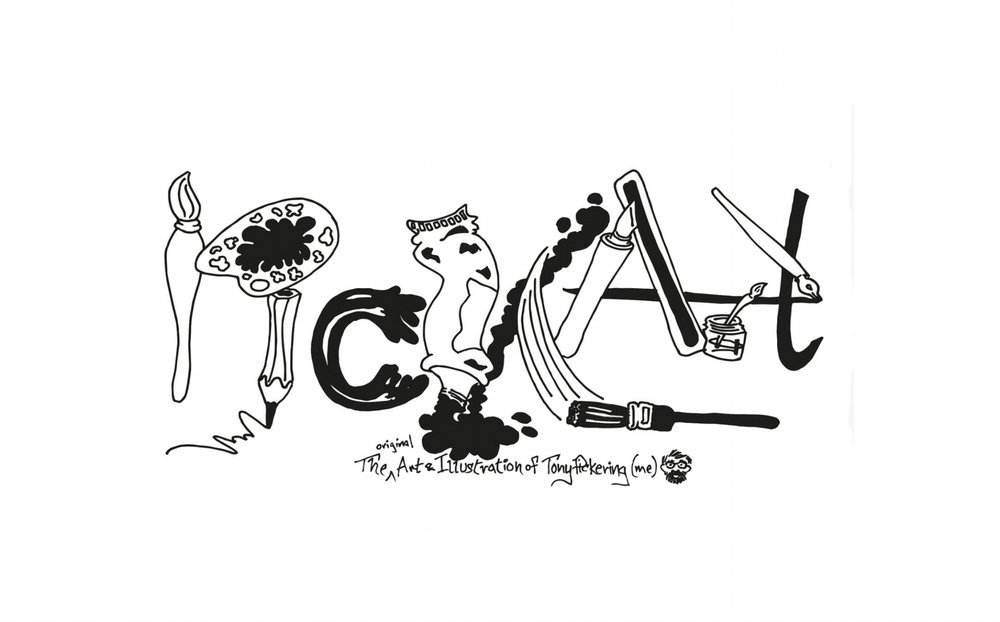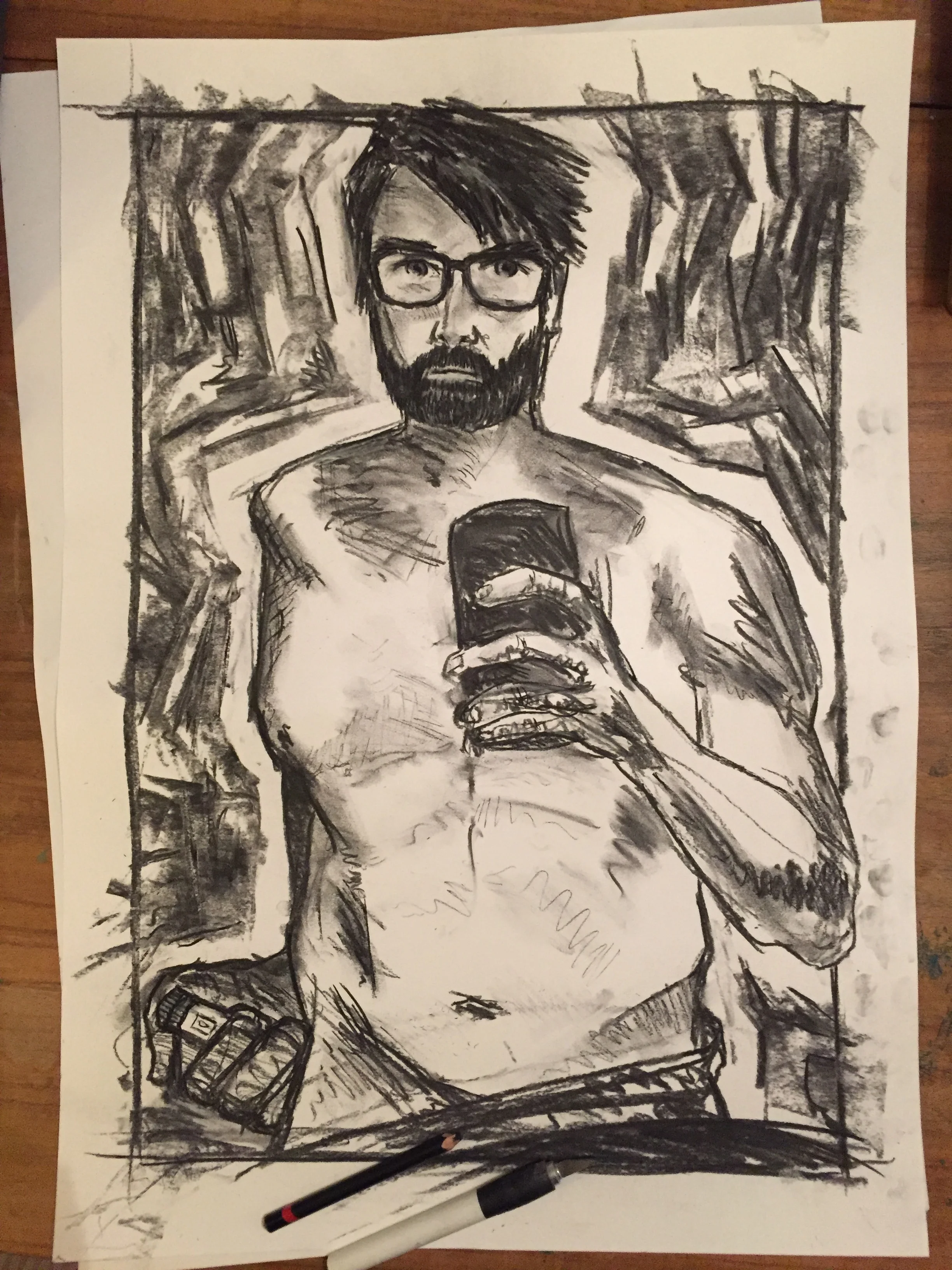I’ve got a few SciArt blogs to write. I know this because I sat down and made a list. It’s a good list – thorough - it has sub-sections and clauses and everything. And I will get around to them… probably.
I’ve been at an impasse recently; Journaling – chronicling my diabetes started to feel muddled. How much of the project is testimony, how much is science, how much is about my emotions, and how much is simply charting the day? My confusion meant I didn’t feel like I was making much progress, so I began to feel a bit… well, helpless.
Pickering, A. 2017: Selfie with injection pen. Charcoal on A2 paper.
Pickering, A. 2017: Autoimmune selfie. Charcoal on A2 paper.
Pickering, A. 2017: Selfie with injection pen and pancreas. Charcoal on A2 paper.
To get going I started to work up some smaller images on a larger scale – starting with variations on a self-portrait. I don’t like showing self-portraits – I never feel you can win – if it’s good – what does that say about you? And if it’s not – well that’s pretty apparent quickly. But in this case it was a useful point to start – after all the journal will consider my view-point, and question myself as character and narrator (I mean, how reliable am I?). Working in charcoal on a large scale I could work quickly, smudge, rearrange, and (especially useful) work in layers of darkness. The images bring out an intensity, and build to a sense of a struggle with myself. The final self-portrait attempts to make explicit the internal life in the context of the outer life, which I hope to explore further.
These images lead to “Inside-out”, an attempt to articulate the scientific discovery, and the tension of living with type 1 diabetes.
Pickering, A. 2017: Inside Out. Charcoal on A2 paper.
For this I drew on the research into immunology which is the basis for the drugs trial I am on - including images of ß-cells and the Islets of Langerhans as well as the detritus and routine of everyday Diabetes. (Steffes, M; Sibley, S;Jackson, M; Thomas, W: ß-Cell Function and the Develop of Diabetes-Related Complications in the Diabetes Control and Complications Trial. Diabetes Care, volume 26, number 3, March 2003. Diabetes Research Institute Foundation https://www.diabetesresearch.org/islet-cells). I found that as well as visual images the frustration of the experience manifested itself - through the scrawl of my writing - forced into aggressive stroke through the charcoal itself, and in the opposing figure - the obscured, yet present 'self' that occupies the same body that I inhabit.
Chromogranin Stain Type 1 Diabetes Islet: "What is most interesting is to look at stains highlighting chromogranin (red) and insulin (green) - significantly less hormone producing and insulin secreting (beta) cells in type 1 diabetes islet." (Dr Anneliese Flatt)
I feel that I’m beginning to find visual language to communicate the fault-line between the discovery and the dealing. Collating these images with my science reading – and incorporating information provided through my collaboration with the Medical staff through my drugs trial - who provided insight into the T1DUK consortium (http://www.type1diabetesresearch.org.uk), and images of stained islets, showing the impact and working of type 1 diabetes, I developed a mind map to begin to isolate themes, ideas and images. The map was then developed through drawing as interpretation – which in turn produced a response in the form of a poem.
"Diabetes map" (pages from my sketchbook)
The map quickly becomes un-structured in the sense that ideas begun on one strand are then carried on in connection with another, developing the sense that the medical science and the life lived are not, and cannot be, isolated from each other.
"Interpretive drawing: images of thought" (pages from my sketchbook)
My drawing overlaps, indicating both my sense of preoccupation and frustration, alongside the way in which the space for diabetes is not separated from life – I experience my disease in the context of what I do – and shape what I do around the presence of my diabetes – something indicated by the central placing of the pancreas. The drawing reveals the potential for further images – from the puerile [me having a piss], to the graphic [pancreas and insulin as a technical drawing for a circuit] to the expressionist [my emotions trapped in a test-tube – exploring the way science can be used to syphon off the pain of emotional engagement] and the geometric [proinsulin molecules as pattern].
A key idea that came through from the map and the drawing, was that of living as a constant process of experiment. Not being able to trust the body, or communicate effectively with it. Instead you need to regulate your biology – you must hypothesise based on knowledge/data (testing), review the results, apply the hypothesis, and test again later. To know if this process works you need to record the results for review at regular periods – and in my case submit the results for expert review. This came out through the poem.
The poem is free-verse – drawing on the jazz inspired form to indicate the frustration that comes from the regular improvisation around the rules that life forces on these little experiments. Some of the the images were developed through this process appear below. In contrast to the free form of the poem, they are clinical in style - even where movement and chaos is referred to, a reference to the opposition between intention, and the disorder of existence. Within the images lies the way in which the structure of this process can provide security - through a narrative of control and progress, whilst at the same time masking the insecurity of the vagaries of blood sugar, and it's medical impact.
Life as a test tube
Test, analyse, apply, revise
Structure – struc-ture
Tick-tock,
5.1, 5.3, 4.6, 3.2 – uh-oh
- sugar, test
Pickering, A. 2017: Test, Analyse, Apply, Revise. Drawing pencils on A2 paper.
- carbs, test
Tick-tock – step, step,
walk and talk, coffee
read, talk
And walk, walk,
carry,
double-back, read,
Test, calculate,
Insert, record;
walking
thinking, drinking, coffee - review
4.6, 4.2 – biscuit, walking,
drawing,
carrying
3.8 – shit, Hold everything! Pause
Test, analyse, apply, revise.
Pickering, A. 2017: Life as a Test Tube. Drawing pencils on A3 paper.
Life as a test tube,
human experiment – the science ring-fences
experience
in graphs of
joy[?] – success –
Happiness
is above the curve.
The everyday.
Every moment – the feeding, the judging and the fixing
(How low can you go? ) – (Can you feel it?)
Why can’t I feel it?
Everyday frustration [thrust-ration: seconds of impetus].
Food, food, glorious… fuel – a foodie on a deadline,
I love the taste of gasoline in the morning – tastes of…
Equations, ratios, probability –
take this – change that, remember the other:
Where X=the random probability of the food matching the whim of the body in a chance scenario.
Moments.
War-cells
ß, ⍺, T – why can’t they all just get along?
Me, myself – and I – I who stab myself in the back,
I who call out
I who watch – and when I need me most, blink.
Single minded – slow throbbing – I can’t, won’t… stop, stop-it!
Stop-it.
Eat, Eat? Eat! – not that! FFS –
good control, under control, regulated, regimented,
Except,
Except:
- We missed that turn on the left
- Have you brought the sandwiches?"
- Shit – what time is it?
- Where do you want to?
- Just a quick meeting to…
Stab,
Bleed,
Test,
Note,
Review
And hope.









